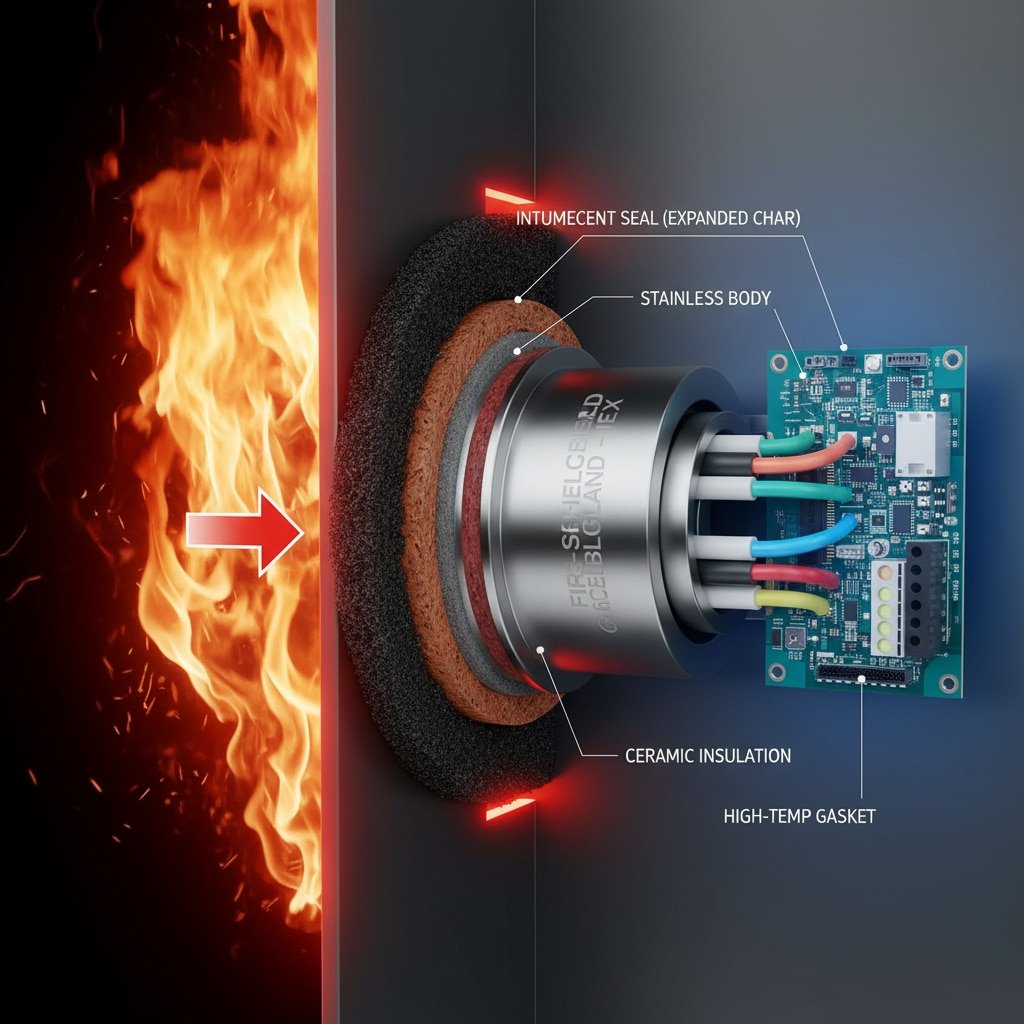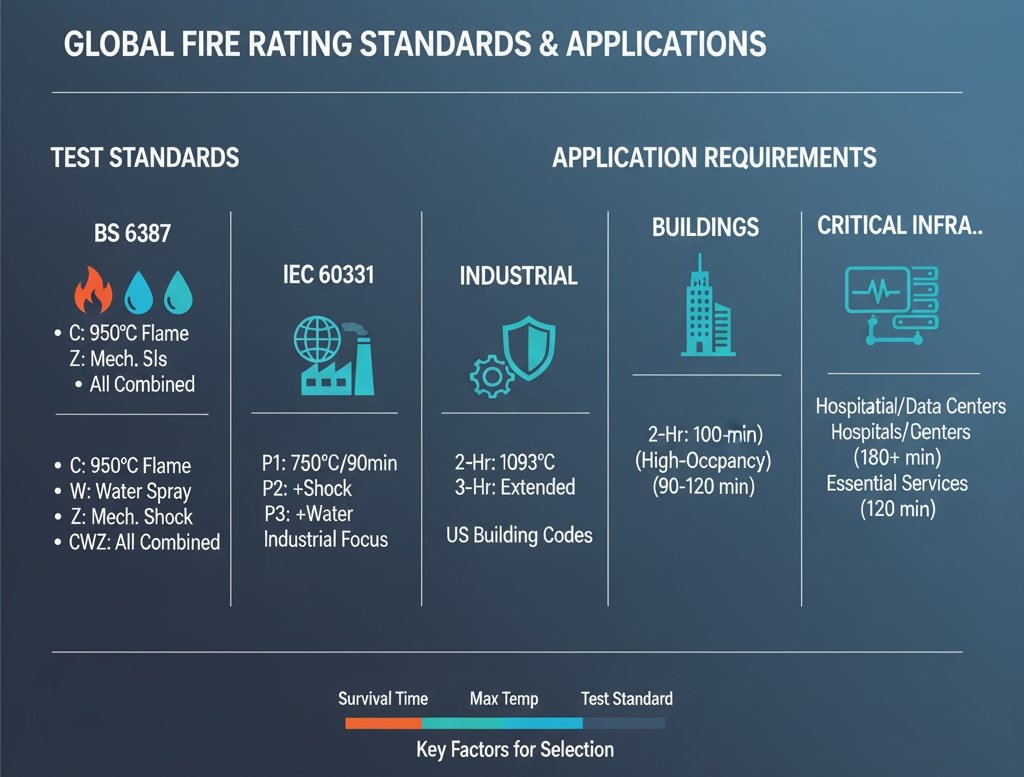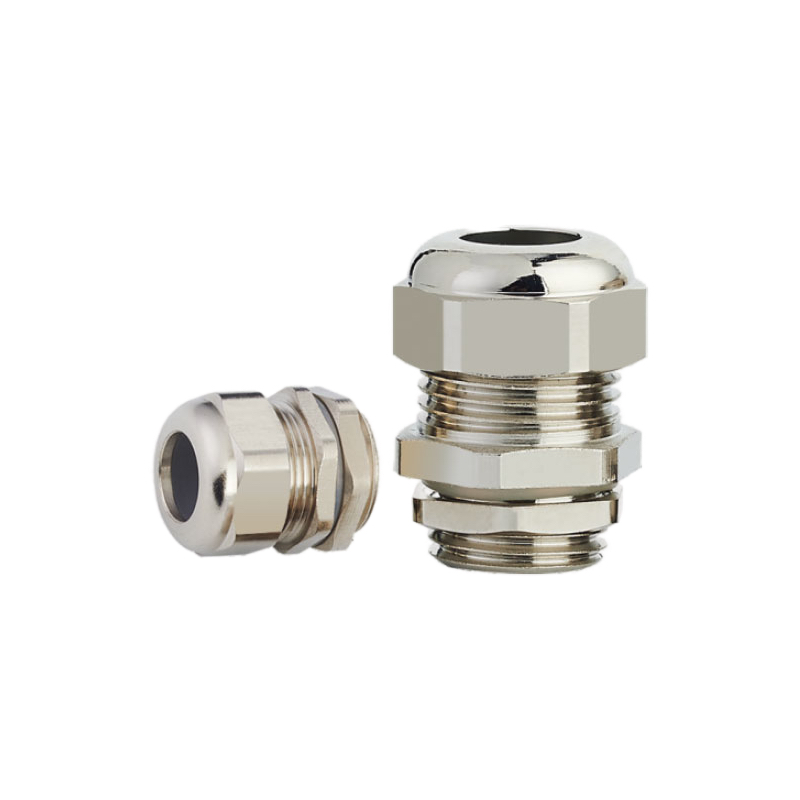When fire strikes an industrial facility, standard cable glands can fail within minutes, causing critical safety systems to shut down exactly when they’re needed most. Emergency lighting, fire alarms, and evacuation systems become useless if their cable connections can’t withstand extreme temperatures and flames.
Fire-resistant cable glands are specially engineered components that maintain electrical ακεραιότητα κυκλώματος1 during fire conditions, featuring intumescent sealing materials2 and high-temperature resistant housings that expand under heat to prevent flame and smoke penetration while preserving power transmission to critical safety systems. These specialized glands can operate for 30-120 minutes at temperatures exceeding 750°C, ensuring life safety systems remain functional during emergencies.
Over the past decade, I’ve witnessed too many facilities discover their “fire-safe” installations weren’t actually fire-resistant when disaster struck. The difference between fire-retardant and fire-resistant cable glands can literally mean the difference between life and death in emergency situations.
Πίνακας περιεχομένων
- What Makes Cable Glands Fire-Resistant?
- Which Critical Circuits Require Fire-Resistant Protection?
- How Do You Select the Right Fire Rating for Your Application?
- What Are the Key Installation Requirements for Fire-Resistant Glands?
- How Do Fire-Resistant Glands Compare to Standard Options?
- FAQs About Fire-Resistant Cable Glands
What Makes Cable Glands Fire-Resistant?
Understanding the engineering behind fire-resistant cable glands is crucial for specifying the right protection level for your critical circuits and ensuring compliance with safety regulations.
Fire-resistant cable glands achieve their protective capabilities through intumescent sealing compounds, high-temperature resistant materials like stainless steel or special ceramics, and multi-barrier designs that prevent flame propagation while maintaining electrical continuity under extreme heat conditions. These components work together to create a fire-rated assembly that can withstand standardized fire tests.

Intumescent Sealing Technology
The heart of any fire-resistant cable gland is its intumescent sealing system. When exposed to high temperatures (typically above 200°C), these special compounds undergo a chemical reaction that causes them to expand dramatically – sometimes up to 10 times their original volume. This expansion creates a char layer that:
- Blocks flame penetration through the cable entry point
- Prevents toxic smoke infiltration into protected areas
- Maintains pressure differential across fire barriers
- Preserves structural integrity of the fire-rated wall or enclosure
High-Temperature Material Construction
Fire-resistant cable glands utilize materials specifically chosen for their thermal performance:
Stainless Steel Bodies: Grade 316 stainless steel maintains structural integrity at temperatures exceeding 800°C, preventing mechanical failure that could compromise the fire barrier.
Ceramic Insulation: Advanced ceramic compounds provide electrical insulation while withstanding extreme temperatures without degradation.
Specialized Gaskets: High-temperature elastomers or graphite-based sealing materials that maintain flexibility and sealing properties under fire conditions.
I remember working with Hassan, a safety manager at a petrochemical complex in Kuwait, who initially questioned the higher cost of fire-resistant cable glands for their emergency shutdown systems. After witnessing a minor fire incident where standard glands failed within 15 minutes while our fire-resistant units continued operating for over an hour, he immediately upgraded all critical circuits. That investment proved invaluable when a major incident occurred two years later – their emergency systems remained fully operational throughout the entire evacuation process.
Which Critical Circuits Require Fire-Resistant Protection?
Identifying which circuits need fire-resistant cable glands is essential for both safety compliance and cost-effective system design. Not every circuit requires this level of protection, but missing critical applications can have catastrophic consequences.
Fire-resistant cable glands are mandatory for circuits that must remain operational during fire emergencies, including fire alarm systems, emergency lighting, smoke extraction fans, fire pumps, emergency communications, and safety shutdown systems as specified by building codes and safety standards like BS 63873 και IEC 603314. These circuits form the backbone of life safety infrastructure.
Life Safety Systems
Emergency Lighting Circuits: Must operate for minimum 90 minutes during fire conditions to ensure safe evacuation routes remain illuminated.
Fire Alarm and Detection Systems: Require continuous operation to monitor fire spread and coordinate emergency response activities.
Voice Communication Systems: Public address and emergency communication systems need uninterrupted power for evacuation instructions.
Smoke Control Systems: Mechanical ventilation and smoke extraction fans must continue operating to maintain safe egress paths.
Critical Infrastructure Protection
Fire Suppression Systems: Sprinkler pumps, deluge systems, and gas suppression controls require reliable power throughout fire events.
Emergency Shutdown Systems: Process safety systems that must activate and remain operational to prevent escalation of fire incidents.
Security and Access Control: Emergency unlock systems for fire exits and security monitoring during evacuations.
Elevator Emergency Power: Firefighter service elevators and emergency evacuation lifts need continuous power supply.
Regulatory Requirements by Region
| Περιοχή | Πρότυπο | Βαθμολογία πυρκαγιάς | Εφαρμογή |
|---|---|---|---|
| Ευρώπη | BS 6387 CWZ | 950°C/3 hours | Life safety circuits |
| Βόρεια Αμερική | UL 2196 | 2000°F/2 hours | Συστήματα έκτακτης ανάγκης |
| Ασία-Ειρηνικός | IEC 60331 | 750°C/90 minutes | Critical infrastructure |
| Μέση Ανατολή | BS 6387 + Local codes | 950°C/3 hours | Petrochemical facilities |
David, a facilities manager at a major hospital in Toronto, learned this lesson the hard way when a kitchen fire spread to electrical rooms. While most systems shut down safely, the emergency generator transfer switches failed because they used standard cable glands instead of fire-resistant ones. The hospital had to evacuate patients in the middle of the night because backup power couldn’t engage. After that incident, they retrofitted all critical power circuits with proper fire-resistant cable glands and haven’t had a single failure in subsequent emergency situations.
How Do You Select the Right Fire Rating for Your Application?
Choosing the appropriate fire rating involves understanding test standards, environmental conditions, and regulatory requirements specific to your application and geographic location.
Fire rating selection depends on three key factors: required survival time (30-180 minutes), maximum temperature exposure (750-1000°C), and applicable test standards (BS 6387, IEC 60331, UL 21965) which vary by region and application type. Higher ratings provide greater protection but come with increased cost and installation complexity.

Understanding Fire Test Standards
BS 6387 (βρετανικό πρότυπο):
- Κατηγορία Γ: Flame resistance at 950°C
- Category W: Water spray resistance during fire
- Category Z: Mechanical shock resistance under fire conditions
- Combined CWZ: Most demanding rating for critical applications
IEC 60331 (International Standard):
- Μέρος 1: Flame alone at 750°C for 90 minutes
- Μέρος 2: Flame with mechanical shock
- Μέρος 3: Flame with water spray
- Widely accepted globally for industrial applications
UL 2196 (Βόρεια Αμερική):
- 2-hour rating: 2000°F (1093°C) exposure
- 3-hour rating: Extended protection for high-rise buildings
- Required for many US building codes
Επιλογή βαθμολογίας ειδικής εφαρμογής
Residential and Commercial Buildings:
- Minimum: 30-60 minute ratings for basic life safety
- Recommended: 90-120 minute ratings for high-occupancy buildings
- Standards: Local building codes typically specify minimum requirements
Βιομηχανικές εγκαταστάσεις:
- Πρότυπο: 90-120 minute ratings for most applications
- High-risk: 180+ minute ratings for chemical processing
- Εκτιμήσεις: Process shutdown time and emergency response capabilities
Κρίσιμες υποδομές:
- Minimum: 120 minute ratings for essential services
- Preferred: 180+ minute ratings for hospitals, data centers
- Special: Custom ratings for nuclear facilities and military applications
Ανάλυση κόστους-οφέλους
While fire-resistant cable glands cost 3-5 times more than standard versions, the investment is minimal compared to potential losses:
- Property damage prevention: Millions in avoided fire damage
- Business continuity: Reduced downtime and operational losses
- Legal compliance: Avoiding fines and liability issues
- Insurance benefits: Lower premiums for properly protected facilities
What Are the Key Installation Requirements for Fire-Resistant Glands?
Proper installation is critical for fire-resistant cable glands to achieve their rated performance. Even the highest-rated gland will fail if not installed according to manufacturer specifications and applicable standards.
Fire-resistant cable gland installation requires certified installers, proper torque specifications, compatible fire-rated cables, appropriate wall/enclosure preparation, and complete documentation to maintain fire rating integrity and ensure warranty coverage. Any deviation from installation procedures can void the fire rating and create liability issues.
Απαιτήσεις πριν από την εγκατάσταση
Installer Certification: Many manufacturers require certified installers for warranty coverage and code compliance. Training covers proper techniques, torque specifications, and testing procedures.
Compatible Components: All system components must have compatible fire ratings:
- Fire-rated cables: Must match or exceed gland rating
- Fire-rated enclosures: Wall or panel must maintain integrity
- Supporting hardware: Brackets, conduits, and fittings need appropriate ratings
Περιβαλλοντική αξιολόγηση: Consider installation environment factors:
- Κύκλωση θερμοκρασίας: Expansion/contraction effects on seals
- Χημική έκθεση: Compatibility with process chemicals
- Επίπεδα κραδασμών: Mechanical stress on connections
- Moisture conditions: Humidity and water exposure risks
Installation Process Steps
1. Προετοιμασία οπής
- Drill holes to exact specifications (typically +0.5mm tolerance)
- Remove all debris and burrs that could damage seals
- Apply fire-rated sealant around hole perimeter if required
- Verify wall thickness meets minimum requirements
2. Cable Preparation
- Strip cables according to manufacturer specifications
- Install any required cable markers or identification
- Check cable fire rating compatibility
- Ensure adequate service loop for future maintenance
3. Συναρμολόγηση αδένα
- Follow manufacturer’s assembly sequence exactly
- Εφαρμόστε τις καθορισμένες τιμές ροπής με βαθμονομημένα εργαλεία
- Verify intumescent material positioning
- Check all sealing surfaces for damage
4. Testing and Documentation
- Perform continuity tests on all circuits
- Document installation details and test results
- Photograph completed installation for records
- Προγραμματίστε τα διαστήματα περιοδικών επιθεωρήσεων
Κοινά λάθη εγκατάστασης
Υπερβολική σύσφιξη: Excessive torque can damage intumescent seals and compromise fire rating performance.
Incompatible cables: Using non-fire-rated cables negates the protection provided by fire-resistant glands.
Improper hole size: Oversized holes prevent proper sealing, while undersized holes can damage the gland during installation.
Missing documentation: Lack of proper installation records can void warranties and create compliance issues during inspections.
How Do Fire-Resistant Glands Compare to Standard Options?
Understanding the differences between fire-resistant and standard cable glands helps justify the investment and ensures appropriate application selection for your specific requirements.
Fire-resistant cable glands provide 30-180 minutes of circuit protection at temperatures up to 1000°C compared to standard glands that typically fail within 5-10 minutes at 200-300°C, making them essential for life safety applications despite being 3-5 times more expensive than conventional alternatives. The performance difference is dramatic when fire conditions occur.
Σύγκριση επιδόσεων
| Χαρακτηριστικό γνώρισμα | Τυποποιημένοι στυπιοθλίπτες καλωδίων | Fire-Resistant Cable Glands |
|---|---|---|
| Fire Survival Time | 5-10 minutes | 30-180 λεπτά |
| Maximum Temperature | 200-300°C | 750-1000°C |
| Circuit Integrity | Fails quickly | Maintains continuity |
| Smoke Sealing | Καμία προστασία | Intumescent barrier |
| Συντελεστής κόστους | 1x baseline | 3-5x baseline |
| Πολυπλοκότητα εγκατάστασης | Πρότυπο | Requires certification |
| Συντήρηση | Ελάχιστο | Περιοδική επιθεώρηση |
| Εγγύηση | 1-2 χρόνια | 5-10 χρόνια |
Application Suitability
When Standard Glands Are Adequate:
- Non-critical circuits that can safely shut down during fires
- Areas with comprehensive sprinkler protection
- Low-occupancy buildings with quick evacuation times
- Προσωρινές εγκαταστάσεις και εργοτάξια
- Budget-constrained projects with minimal fire risk
When Fire-Resistant Glands Are Essential:
- Life safety systems (alarms, lighting, communications)
- Emergency power and control circuits
- High-occupancy buildings and critical facilities
- Industrial processes requiring safe shutdown
- Απαιτήσεις κανονιστικής συμμόρφωσης
Ανάλυση μακροπρόθεσμης αξίας
While initial costs are higher, fire-resistant cable glands provide superior long-term value:
Μετριασμός κινδύνου: Prevents catastrophic failures that could result in loss of life and massive property damage.
Ασφαλιστικές παροχές: Many insurers offer premium reductions for properly fire-protected facilities.
Κανονιστική συμμόρφωση: Avoids costly retrofits when codes change or during facility upgrades.
Operational Continuity: Maintains critical systems during emergencies, reducing business interruption losses.
Reputation Protection: Demonstrates commitment to safety and regulatory compliance to stakeholders.
Συμπέρασμα
Fire-resistant cable glands are not just another component – they’re life safety devices that can mean the difference between successful emergency evacuation and catastrophic failure. While the initial investment is higher than standard alternatives, the protection they provide for critical circuits is invaluable when fire conditions occur. Remember that proper selection requires understanding fire ratings, regulatory requirements, and installation specifications. Whether you’re protecting emergency lighting with our Bepto fire-resistant nylon cable glands or securing critical shutdown systems with stainless steel variants, investing in proper fire protection today prevents devastating losses tomorrow. Don’t wait for an emergency to discover your critical circuits aren’t properly protected! 😉
FAQs About Fire-Resistant Cable Glands
Q: How long do fire-resistant cable glands actually last during a fire?
A: Fire-resistant cable glands are rated for 30-180 minutes depending on the specific standard and rating, with most life safety applications requiring 90-120 minute protection. The actual survival time depends on fire intensity, installation quality, and cable compatibility.
Q: Can I use fire-resistant cable glands with regular cables?
A: No, fire-resistant cable glands must be paired with fire-rated cables to achieve the complete system rating. Using standard cables will cause circuit failure regardless of the gland’s fire resistance, as the cable insulation will fail first.
Q: What’s the difference between fire-retardant and fire-resistant cable glands?
A: Fire-retardant glands slow flame spread but don’t maintain circuit integrity during fires, while fire-resistant glands are designed to keep circuits operational for specified time periods under fire conditions. Only fire-resistant types should be used for critical life safety circuits.
Q: Do fire-resistant cable glands require special installation tools?
A: Yes, proper installation requires calibrated torque wrenches, certified installers, and specific techniques to maintain the fire rating. Many manufacturers require installer certification and provide specialized tools to ensure correct installation procedures.
Q: How much more expensive are fire-resistant cable glands compared to standard ones?
A: Fire-resistant cable glands typically cost 3-5 times more than standard versions, but this represents a small fraction of total project costs while providing critical life safety protection. The investment is minimal compared to potential fire damage and liability costs.
-
Understand the concept of circuit integrity and why it’s crucial for life safety systems during a fire. ↩
-
Learn about intumescent materials and how they expand when heated to form a fire-resistant char layer. ↩
-
Review the details and categories (C, W, Z) of the British Standard BS 6387 for fire-resistant cables and systems. ↩
-
Access information on the international IEC 60331 standard for testing circuit integrity under fire conditions. ↩
-
Explore the requirements of the North American UL 2196 standard for fire-resistive cables and systems. ↩



